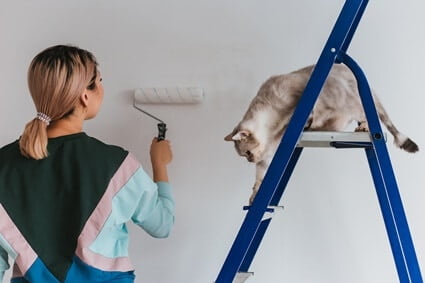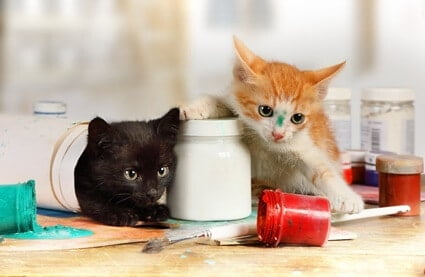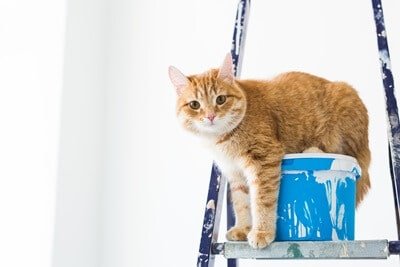Cats have a habit of wandering to areas where they don’t belong. Paint, from leaning on a wet surface or rolling in a spillage, can be troublesome. This will stain your cat’s fur if not cleaned and could be toxic if consumed.
Wet paint is easier to clean from a cat’s fur. Apply cooking oil to your cat’s fur to soften it. Allow this to sit for a few minutes, then give your cat a bath. If the paint has dried, brush the fur and trim any stained areas with scissors. Check your cat for any signs of ill health as paint can cause toxicity or allergic reactions in felines.
If your cat has paint on its fur, early action will deliver the best and fastest results. Wet paint is significantly easier to clean than dry paint. Also, the faster paint is removed, the less likely your cat is to lick it.
How to Remove Paint from Cat Fur
If you are decorating, your cat will be intrigued about what you’re doing. This, coupled with the strong scent of paint, will inspire your cat to investigate. If the cat leans on a painted surface, it will stick to its fur.
Paint spillages and leaks must also be dealt with swiftly. Cats may sit or roll in paint, whether by accident or design. This is common in garages and sheds. Your cat may end up covered in paint, or it may just stain its paws. Some cats also dip their tails in the paint.
Other cats may end up with stains on their nose and whiskers due to scenting paint. In this instance, never cut a cat’s whiskers. These will be painful and impact the cat’s balance. You’ll need to slowly, delicately, and methodically remove the paint.

Removing paint from a cat’s fur may require vigorous scrubbing and cleaning. Many cats will dislike this intensely. If your cat has paint on its fur, follow these steps to remove it:
- Restrict your cat’s movements to a single location
- Calm the cat down with petting and soothing words
- If available, fit the cat with an Elizabethan collar to restrict grooming
- Rub vegetable or olive oil on your cat’s fur, coating the paint
- Leave this to sit for around two minutes
- Rub the oil solution with paper towels until the paint is lifted
- Give your cat a bath using a feline-friendly shampoo
The longer paint clings to feline fur, the likelier the cat is to lick it off. This could have consequences for your cat’s health. If you lack the confidence to clean your cat’s fur, make an appointment with a groomer.
Is Paint Dangerous to Cats?
The most dangerous paint to felines is lead-based. A study in The Journal of Veterinary Diagnostic Investigation found that a third of cats that consumed lead paint grew sick. This is referred to as lead toxicity.
The good news is that lead paint has been illegal since 1977. This is due to the safety concerns associated with the product. Old homes and buildings may still be coated with lead paint, though. This can flake. If a cat eats paint chips, lead toxicity becomes a possibility. Symptoms to look out for after a cat ingests paint are as follows:
- Vomiting and diarrhea
- Lack of coordination and clumsiness
- Labored breathing
- Tremors and seizures
- Depression and uncharacteristic lethargy
- Loss of appetite
- Staring, dilated pupils
- Discolored gums
You should also look out for allergic reactions. Paint can be an irritant to many cats, especially when applied to the skin. An allergic reaction will pass, but it will be unpleasant for your cat. Symptoms include:
- Coughing and sneezing
- Discharge from the eyes and nose
- Vomiting and diarrhea
- Hives and hotspots on the skin
- Constant itching of the skin
There are many different types of paint, which will have varying impacts on a cat’s health. Overall, it is always better to be safe than sorry. Never assume that paint on a cat’s fur is harmless. When your cat grooms itself, it will likely ingest paint on the fur.
Acrylic Paint
Acrylic paints are considered the most pet-safe product. Acrylic paints rarely contain toxic chemicals. They can still cause a stomach upset in cats, though. Never allow a cat to approach wet acrylic paint.
Thankfully, as acrylic paint is waterproof, it can also be easier to remove from the fur. You may not even need shampoo. Sometimes, simple dish soap is enough to eradicate this paint. This means that you can conduct ‘spot cleaning’ on your cat.
Acrylic paint should not have any detectable aroma. If you can smell acrylic paint, throw it away. This suggests that the paint has gone bad and spoiled. Bear in mind that felines have a strong sense of smell. Your cat may still investigate wet acrylic paint.
As with all paints, it’s best to keep cats away from surfaces drying with acrylic paint. While this substance is unlikely to cause serious harm, it is not entirely safe. The aroma can cause neurological issues, and it’s a nuisance to clean out of a cat’s fur.
Latex Paint
Most modern latex paints are considered safe for pets. Some brands contain glycol, though. Swallowed in large quantities, this can lead to urinary tract infections and breathing difficulties. Left untreated, glycol consumption can also lead to acute renal failure.
The real risk with latex point involves the smell – before and after it is used. If you store your latex paint in a cool place, it may separate in the tin. This will release the scent of ammonia into the air, comparable to feline urine. This will attract a cat’s attention.
The cat will investigate, wondering if a rival feline is attempting to claim territory through marking. The cat will interact with the paint, possibly knocking it over. Fur staining can then follow. Thankfully, as a water-based product, latex paint is easier to remove from the fur.
Latex paint can still have an impact when applied to a wall. Depending on the ingredients used in the paint, it may form carcinogenic gas while drying. The strong smell will also impact a cat’s keen nose. To be safe, separate cats and drying latex paint with closed doors.
Gloss Paint
Gloss paint falls into a similar category to latex paint. The vast majority of gloss paints are now water-based, rather than oil. This minimizes risk if your cat consumes such paint. Small quantities can still lead to vomiting and diarrhea, though.
As with latex paints, the scent of gloss is arguably the biggest risk. It can take quite some time for gloss paint to dry. These fumes will be strong, especially in poorly ventilated rooms. Never enclose your cat in such a location.
Oil Paint
Oil-based paints, including those used by artists, can be troublesome for cats. Oil-based paints contain more chemicals than water-based alternatives. This leads to a heightened risk of toxicity. Oil-based paints can also be stubborn and tougher to remove from fur.
Oil-based paints may also contain lead. We discussed how lead paint is now outlawed as a base ingredient. Traces may still be found in oil paints, though. In most cases, this will not be enough to provoke lead toxicity.
Many oil-based paints also contain solvents to bind the paint together. These can be dangerous to a cat. At best, your cat will struggle with vomiting and diarrhea. At worst, these solvents can impact feline internal organs. The lungs and kidneys are at particular risk.
Even artistic oil paints purchased from a hobby store can be risky. These paints will contain pigments to achieve particular shades. These pigments are dangerous to cats. Thankfully, hobby paints are often smaller in size. This makes excess fur coverage less likely.
Spray Paint
Spray paint is best avoided if you live with cats. Spray paint is invariably oil-based, so that it may contain harmful chemicals. Spray paint can also take a long time to dry, especially when applied to metal. This enhances the risk of a cat touching and consuming the paint.
In addition, spray paint is arguably the strongest-smelling paint of all. A human can suffer severe headaches due to the scent of spray paint. Annals of Neurology confirms that spray paint can cause neurological dysfunction.
Consider that cats have much more powerful noses and smaller bodies. This means that the impact of spray paint will be magnified. A cat could become seriously ill, or worse if exposed to this material.
Spray paint is often considered a significant skin irritant. Exposure to this product will leave your cat in severe discomfort. This will be magnified if you need to scrub your cat’s fur clean. To reiterate, cats and spray paint should never mix.

Removing Dry Paint from Cat Fur
The biggest risk of dry paint is not knowing how it got there. Different paint types dry at different speeds. If your cat presents with dry paint on its fur, it may have already consumed paint. Be vigilant about watching for signs of toxicity. If your cat is fine, you can clean it off.
In theory, dry paint is easier to remove than wet paint. The bad news is, it is unlikely to be cleaned off with bathing. Instead, you will need to cut the impacted fur out with scissors.
Adopt the cooking oil and shampoo method that we previously profiled. This will likely go some way to cleaning up the fur. It will not get everything, though. Once you have finished in the bathtub, dry your cat off and prepare for phase two.
Get a fine-toothed comb and run this through your cat’s fur. Do not leave any inch of your cat’s body unbrushed. You need to expose every flake of dry paint.
Once you have done so, calm your cat and reach for a sharp pair of scissors. Cut out stained fur. Only cut as much as you need, ideally never trimming more than the tip of fur. Be careful not to cut a cat’s delicate skin. Keep going until your cat’s fur is paint-free.
A cat’s fur stained with paint is always a concern. The longer a cat has paint in its fur, the likelier staining is to be permanent. In addition, the ingestion of potentially toxic paint is an ever-present risk.

